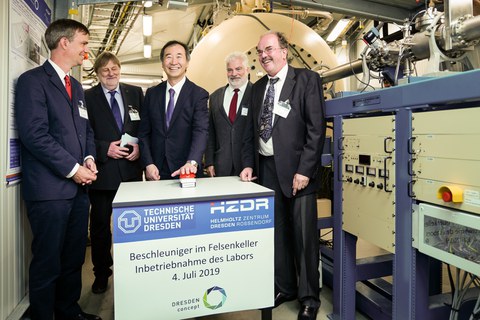Jul 04, 2019
Nobel Laureate in Physics Takaaki Kajita unveils accelerator in Dresden’s Felsenkeller Laboratory

Daniel Bemmerer (HZDR), Gerhard Rödel (TU Dresden), Nobelpreisträger Takaaki Kajita (University of Tokyo), Thomas Cowan (HZDR), Kai Zuber (TU Dresden)
Journey to the Centre of the Sun
What exactly goes on inside our Sun and the other innumerable stars in the universe? This question fascinates scientists worldwide. Thus far, however, it was only possible to search for answers at two locations. After two years of construction, a third research facility has now been completed: The Felsenkeller Laboratory, established in a joint venture by the Helmholtz-Zentrum Dresden-Rossendorf (HZDR) and TU Dresden, was inaugurated on 4th July. The research facility, located on the south-western outskirts of Dresden in a former storage site of the Felsenkeller brewery, was unveiled by Professor Takaaki Kajita, winner of the Nobel Prize in Physics from the University of Tokyo.
"The underground accelerator in the Felsenkeller will be a valuable tool for understanding the origin of the elements in the universe and for making more precise predictions about neutrino flux from the Sun. Since this facility is available to scientists from all over the world, the entire community of nuclear astrophysicists will benefit from it. As a neutrino and gravitational wave physicist, I am really looking forward to seeing new data from the Felsenkeller underground accelerator," said Kajita at the opening ceremony for the ion accelerator, which is located below a layer of rock at a depth of 45 metres. The laboratory in Dresden is only the second of its kind in Europe and the third in the world. "We are now capable of simulating the fundamental processes that take place in all stars," added Dr. Daniel Bemmerer of the HZDR, Technical Director of the Felsenkeller Laboratory.
With this inauguration, the project has come full circle. Professor Arthur B. McDonald from Canada, who shared the Nobel Prize in Physics with Kajita in 2015, gave the ceremonial address at the site two years ago, on 28th June 2017. Kajita and McDonald were awarded the prize for their discovery that elementary particles released by reactions inside the Sun undergo a transformation on their way to Earth, a phenomenon known as neutrino oscillation.
In the wake of this discovery, physicists across the globe have been working to improve models of the Sun in order to obtain more accurate predictions about the number of neutrinos emitted by it before oscillation. In the new laboratory, it will be possible to create simulations of nuclear reactions inside the Sun. Because these reactions take place very slowly, they can only be studied underground in extremely sheltered accelerator laboratories. The rock surrounding the Felsenkeller Laboratory forms a natural shield against cosmic radiation – radiation that bombards the earth with particles every second. "Since this skews our measurements, we cannot carry out these experiments on the Earth's surface," explains Kai Zuber, Professor of Nuclear Physics at TU Dresden and Scientific Director of the laboratory.
The cooperation between the physicists Zuber and Bemmerer in the Felsenkeller Laboratory is a prime example of a successful collaboration between Dresden's research institutions within the DRESDEN-concept alliance.
Media enquiries
Press office (TUD)
Tel.: +49 351 463-32398
Simon Schmitt (HZDR)
Tel.: +49 351 260-3400
Mobile: +49 175 874 2865
http://www.hzdr.de
